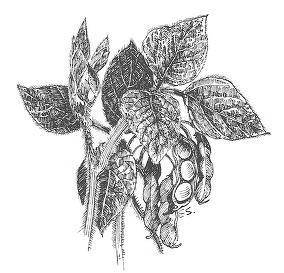The bean family ranges far and wide. Here are two other bean-types that are easy to grow and nutritious.
 Nutrient-Packed Soybeans
Nutrient-Packed SoybeansSoybeans are regarded as "the meat of the fields" in China. They contain about three times more protein than any other member of the legume family (beans, peas, etc.), only a small amount of sugar and no starch. To top it off, they also contain calcium and B vitamins. What more can one ask of a bean? In the Orient, soybeans have been used for centuries in all different forms. The form we know best, of course, is soy sauce. In this country, commercial food processors discovered soybeans after World War II, and they've been using them ever since in all sorts of ways.
Ways to Prepare ThemThe drawbacks to soybeans are that they are almost tasteless, and they can take a long time to prepare. But their versatility outweighs these drawbacks. They can be served as sprouts or dried and, whole or ground, served as substitutes for milk, meat, bread or nuts. They can be baked, fried or steamed and added to other foods. When they're seasoned and flavored, they can be very tasty. However, soybeans are low in one of the essential amino acids - methionine. This is not a problem if soybeans are served with a small amount of animal protein, such as a glass of milk. And, of course, soybeans aren't a complete food. It's always important to have a varied diet.
EdamameWhen soybeans are harvested in the green rather than the dry stage, they're called "vegetable" or "edible" soybeans. Two good varieties for the home garden are 'Butterbean' and 'Envy'. Steam them for a few minutes and pop them out of their pods to enjoy their nutty flavor.
Southern Peas are Really Beans
It may seem odd to be talking about peas in a bean book, but the southern pea varieties, such as black-eyed, are not peas at all. They're beans. And just because they're called "southern" doesn't mean they can't be grown successfully up North, either. These peas just need warm soil to germinate. If you can grow lima beans, which also require warm soil, you can grow all sorts of southern peas. If you grow southern peas in wide rows, the plants will grow lush and thick and produce about 1-1/2 pounds of peas per foot of wide row. Pick the peas green when the pods are filled out but before the hulls are dry. If you want to store the peas dry, just leave them on the vine until the plants are thoroughly mature and dry.

Southern Pea Varieties
Black-eyed, crowder and cream peas are the best known types of southern peas. The name "crowder" is tagged to many southern peas, but is supposed to refer to the types where the peas are jammed together in the pod. Cream peas generally have smooth pods filled with small white peas. Varieties to try include 'California Black Eye', 'Purple Hull Cowpea', and 'Mississippi Silver'.
 Victory Seed Company has all the seeds you want for your best garden in 2024.
Victory Seed Company has all the seeds you want for your best garden in 2024.
For 25 years, the family-owned Victory Seed Company has provided the highest quality vegetable, herb and flower seeds to families across the country. We are passionate about providing you the best seeds available that give excellent germination, robust plants, and the harvest you want. With a catalog of over a thousand varieties, we have everything, and our prices are the kinds that we'd want to pay. We have hundreds of yesterday's heirloom vegetables, as well as today's award winning hybrid selections. Get to know us by visiting our website and browsing through our online vegetable seed catalog.
| 1. Bush & Pole Bean Varieties |
| 2. Bean Essentials |
| 3. How Beans Grow |
| 4. Soybeans & Southern Peas ← you're on this article right now |
| 5. Soil Preparation for Beans |
| 6. Buying Bean Seeds |
| 1. Bush & Pole Bean Varieties |
| 2. Bean Essentials |
| 3. How Beans Grow |
| 4. Soybeans & Southern Peas ← you're on this article right now |
| 5. Soil Preparation for Beans |
| 6. Buying Bean Seeds |